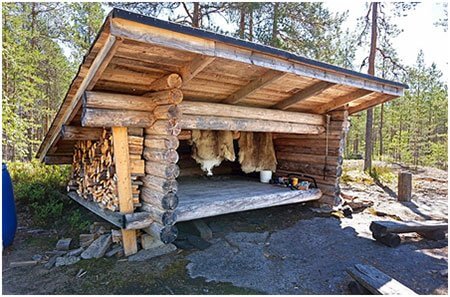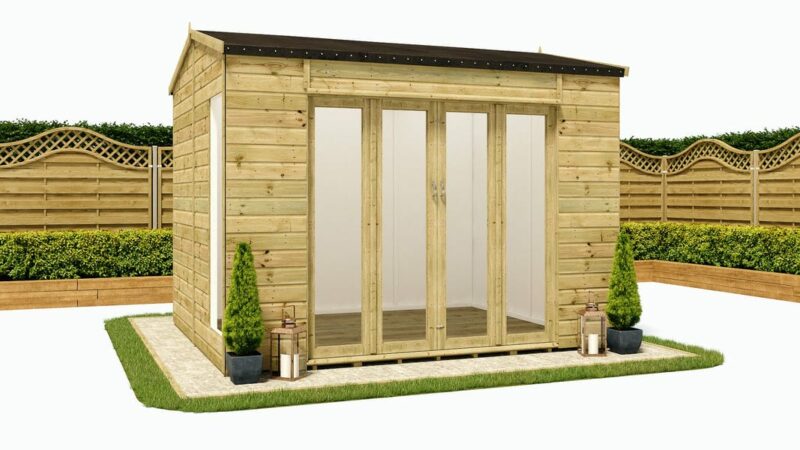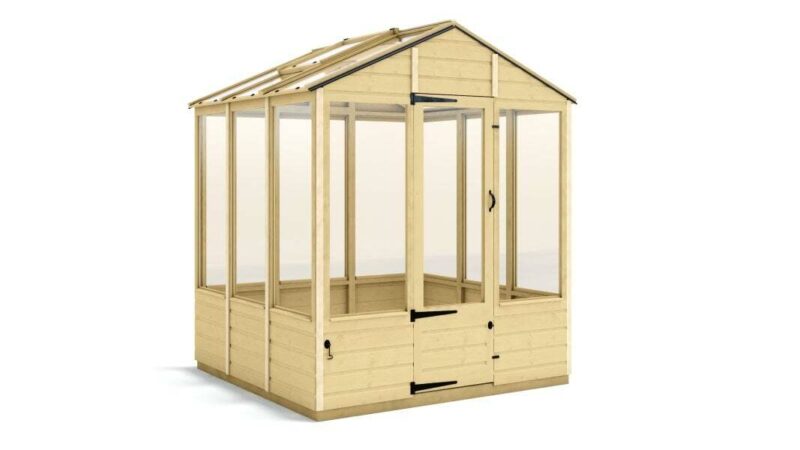How often do you think about sheds? There’s a good chance that you’ve thought about investing in a shed once or twice, but the thought quickly left your mind. If you have gardening tools, yard toys, and perhaps even outdoor furniture you would benefit greatly from a shed. Once upon a time, sheds were infamously un-fabulous structures that stuck out like a sore thumb in your yard. Sure, you could always paint them to make them more aesthetically appealing, but there’s only so much you can do with a plywood structure. Nowadays, there is an almost endless selection of shed types to choose from:
- Greenhouses
- Metallic Sheds
- Timber Sheds
- Greenhouses
- Playhouses
- Much more
The purpose of this guide is to educate you on everything about sheds. By the time you’re finished you’ll have an understanding of shed features, design, purpose, and function. We’ll touch on every aspect there is to know about sheds so by the time you’re done reading you’ll be official expert!
Shed Types
Simply knowing the fact that you need a shed in the first place is only half the battle. Now you need to determine the best type of shed that will best suit your purposes. There are a ton of factors that goes into determining the type of shed you’ll need:
- Use
- Climate
- Space
- Cost
- Preference
That’s a lot to think about. To give you a better idea of the type of sheds that you can purchase, check out this list:
Pressure Treated Pent Offset Door Garden Shed

The Pent Offset Door Garden Shed has a simple design that’ll beautify your yard.
Hobbyist Tall Garden Shed

As the name implies, this shed was designed for the hobbyist who requires a taller shed.
Grasmere Garden Shed

Sporting windows and a sturdy design, this shed’s smaller size will allow you to tuck it away into a quiet, cozy corner of your yard.
Corner Windowed Shed
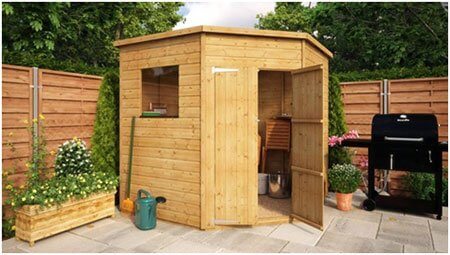
The corner window and double doors gives this shed a certain charm, wouldn’t you say?
Traditional Windowless 2 Doors Grandmaster Workshop Shed

With its larger size and impressive width, storage will no longer be a problem. You can store practically everything you need and still have room to work on projects.
Pressure Treated Traditional Windowless Grandmaster Workshop Shed
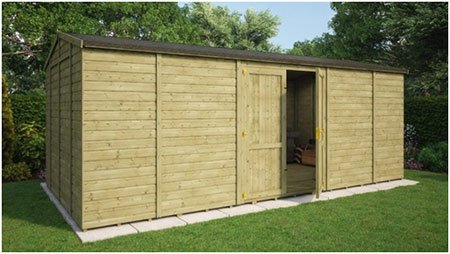
A good sturdy shed where you can store all of your outdoor belongings. It has a very high quality design and is pressure treated to increase the life of your shed.
Pressure Treated Corner Windowless Shed

Do you lack space in your yard? Don’t worry, this pressure treated windowless shed will only occupy a small corner of your yard!
Pressure Treated Loglap Windowed Garden Shed

This pressure treated roomy shed is the perfect storage unit.
Cladding
For those unfamiliar with what it is, cladding is the application of one material over another to provide a skin or layer. For example, cladding is often used in construction to provide thermal insulation and weather resistance. Cladding also improves the appearance of buildings. Cladding is often overlooked. However, it is an essential aspect of garden sheds and timber structures.
There are many types of cladding. Some are better known than others, but they can often be distinguished from the quality of construction, material, and price. Here is a list and an explanation of all of the various types of cladding available.
Cladding Types
Square Edge – square edge cladding is one of the most popular overlap cladding types used in garden sheds. Typically this cladding type falls into a mid-price range.
Shiplap – shiplap cladding is typically more aesthetically pleasing than other cladding types. This cladding type can be thicker than other claddings depending on the supplier.
Tongue and Groove – this is one of the more expensive cladding types. T&G minimizes warping and features an expansion gap to compensate for moisture and heat.
Feathered Edge – due to the nature of the panel cut, feathered edge cladding saves material and is less expensive than Square Edge cladding.
Rebated Feather-Edge – this is an overlap cladding that draws similarities to feather edge construction. Rebated Feather-Edge provides sturdier construction due to a snug panel fit.
Feather Open Jointed – this cladding type is perhaps the most uncommon though it is an available option for those interested.
Overlap Cladding
Overlap cladding is both the most popular and the most common cladding type available. Keep in mind that overlap cladding isn’t necessarily the best cladding to work with. However, it saves the consumer money and is easy to use when building. Overlap cladding typically consists of 8mm sawn-timber; where slats are layered on top of each other and nailed down to create an “overlap”.
Here are a few pros and cons to consider when using overlap cladding:
Pros
• Protects from the elements when treated
• Relatively inexpensive
• Durable and reliable
Cons
• Not suitable for attaching shelving or heavy items on the wall
• If placed in an area that’s continuously sunny, overlap cladding is susceptible to warping
Treatment
If you want your shed to last, you’ll want to treat your overlapping cladding with a spirit-based solution to provide the wood with a layer of protection from the elements. Furthermore, you could touch up your shed with a water-based outdoor paint that also protects from the elements. Brands such as Cuprinol Garden Shades provide this type of paint, amongst other brands. Keep in mind that you’ll need to touch up your shed every 12 months to guarantee that your shed is protected from the elements.
To obtain the maximum amount of protection, you should first treat the overlap with a spirit-based solution. After that, you can then go over it with a water-based paint. Keep in mind that the color of the paint may be slightly off when laid over timber that has been treated with spirits.
Shiplap Cladding
In many cases, shiplap and T&G cladding are often mistaken for each other. What makes shiplap cladding so distinct from T&G is the small channel/groove that runs parallel to the timber. This may seem like a minor difference, but this channel is very important because it directs precipitation away from the shed quickly and efficiently. Furthermore, shiplap cladding is pleasing to look at due to its neat, interlocking panel system. It also provides extra strength to the shed.
Pros
• Aesthetically pleasing to look at
• Has a high resistance to moisture
Cons
• More expensive than overlap cladding
Treatment
At the bare minimum, you should treat your shiplap cladding with a spirit-based solution. This will provide the wood with an extra layer of protection against the elements. You can also use water-based outdoor paints that also protect against the elements. You can buy such paints from Cuprinol Garden Shades, amongst other manufacturers. Just like previously mentioned, this paint will need to be reapplied every 12 months to ensure that your shed is receiving the maximum amount of protection.
To obtain the maximum amount of protection, you should first treat your shiplap cladding with a spirit-based solution. After that, you can then go over it with a water-based paint. Keep in mind that the color of the paint may be slightly off when laid over timber that has been treated with spirits.
Tongue & Groove (T&G) Cladding
Not only is T&G cladding practical but it’s great to look at. Sheds equipped with T&G cladding are incredibly sturdy due to the interlocking exterior design that has made T&G so popular. Individuals who need to store heavier objects should definitely go with this option. The T&G interlocking design also keeps out water, so you’ll never have to worry about leaks. No matter the climate, T&G cladding provides maximum protection.
Pros
• Timber can’t warp
• Nice to look at
• Provides maximum structural integrity
• Shuts out the elements
• Provides additional security
Cons
• Despite being water-tight, shiplap is still more effective at facilitating rainwater run-off
• More expensive than an overlap shed
Treatment
At the bare minimum, you should treat your T&G cladding with a spirit-based solution. This will provide the wood with an extra layer of protection against the elements. You can also use water-based outdoor paints that also protect against the elements. You can buy such paints from Cuprinol Garden Shades, amongst other manufacturers. This paint will need to be reapplied every 12 months to ensure that your shed is receiving the maximum amount of protection.
To obtain the maximum amount of protection, you should first treat your T&G cladding with a spirit-based solution. After that, you can then go over it with a water-based paint. Keep in mind that the color of the paint may be slightly off when laid over timber that has been treated with spirits.
Waney Edge Cladding
Waney edge cladding consists of overlapping boards that are cut directly from a felled tree. Waney Edge cladding isn’t terribly popular, especially in modern garden shed designs due to its lack of durability and inefficiency. In other words, there are better cladding choices for you to spend your money on. It may be very affordable and gives off a rustic traditional aesthetic, but it’s safe to say that it’s a disaster just waiting to happen.
Pros
• Cheap (in the short term)
• Has a unique, rustic look
Cons
• Does not provide any additional structural strength whatsoever
• Has a heightened sensitivity to exposure to the elements
• A much higher chance of warping due to moisture and temperature
Roof Types
This may seem obvious (because it is), but the roof is perhaps the most essential aspect of your shed. Without a good, solid roof to block out the elements, you might as well leave all of your stuff lying about in the yard. Just like cladding, roofs are offered in a wide variety of styles and materials.
Apex Roof

Apex roofs provide a high, central ceiling providing the perfect environment for a workspace. Construction features include two, separate sections that form a joint at the highest point. Just think of an upside down V shape.
Pent Roof

Perfect for gardens with only a small amount of space. You can fit a pent shed against fences, walls, or overhanging trees. The pent roof provides one of the most practical designs out of all of the roof types.
Lean-To
Lean-tos are versatile in the sense that they can be either Apex or Pent style. Lean-tos only have a single wall, so it’s best if you leaned them against a fence or building.
Canopy
Canopies are great for extending the length of an already existing structure, such as a shed. Therefore, you can sit underneath the canopy to escape the rain or the sun as you lean your back against the shed. Canopies are offered in both the Apex and Pent style.
Barn Roof
Barn roofs offer a high ceiling, low eaves, and an angled shape. The design naturally encourages precipitation run-off and is typically a feature of higher-end sheds.
Curved Roof
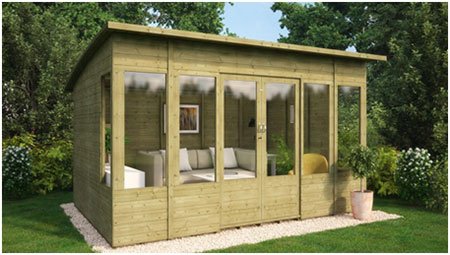
You won’t find many curved roofs in the garden shed industry. You’ll typically only find curved roofs on summerhouses. Once again, curved roofs are very RARE. The likelihood that you’ll ever encounter one is very slim.
Roof Materials
With its continual exposure to the seasons, sunlight, and the elements your roof will eventually wear down. In fact, it’s typical that a roof will need to be replaced every 10 – 15 years.
Most roofs consist of two materials – wood and roof felt. These materials work in tandem with each other to provide a strong and reliable structure. The wood is used to form the frame and foundation of the roof. Meanwhile, the felt will act as a protective layer that shields the wood from the elements.
Polypropylene Roofing
If you’ve ever noticed a roof that had a glossy look to it, the building material was likely polypropylene. Though it protects from the elements, polypropylene isn’t very popular. One of the benefits of polypropylene roofing is that it reduces build times by up to 66%. Furthermore, it’s UV stabilized and can handle most weather conditions in Britain (constant rain). Polypropylene is a fantastic insulator and virtually requires zero maintenance. On the other hand, polypropylene is thin and thus can’t handle heavy weight such as excessive snowfall. If you live in an area that experiences substantial snowfall, it would be best to invest in another roof type such as onduline or wood.
Framing
A lot goes into framing, but this general rule of thumb will always apply: the thicker the better. In many cases, manufacturers will only use the minimal amount of framing to save on material costs. Furthermore, manufacturers use the phrase “extra-strength” to describe framing (when relevant). This is especially the case when describing the strength of a specific part of the shed.
Treatment
Pressure treatment
The name says it all. Pressure treatment occurs when timber undergoes a process in which pressure is used to force chemical preservatives deep into the wood and grain. Pressure treatment helps to increase the lifespan of the timber by helping to deter fungal decay and rot. This typically happens during the manufacturing process, so the timber will not require any additional treatment before or after the shed has been constructed.
Dip Treatment
Though not as thorough as pressure treatment, dip treatment is used to apply a preservative to the surface of the wood. Most timber structures that sport a cedar-red hue have been treated to dip treatment.
Most manufacturers guarantee that dip treated timber will last for about ten years, but in most cases, you’ll have to reapply the dip treatment at least once every 12 months. This way, your wood will last longer as it fends off rot and decay. When it comes to price, dip treated timber is cheaper than pressure treated wood. However, preservation costs really do mount up over time.
Floors and Doors
In most cases, sheds come with a floor. This isn’t always the case, so check with the manufacturer to avoid any undue surprises. It’s essential that you never place a garden shed on the bare ground. Otherwise, you’re inviting insect infestation and wet rot. Purchasing a shed base should be mandatory no matter your budget.
Doors
Sheds have an interesting relationship with doors. Sure, doors (like every other aspect of sheds) come in a variety of materials, styles, sizes, etc. but you can also go with the option of NO door. The choice is up to you! For those who have decided to purchase a shed with a door,read on to learn about the most common door types.
Single Door
This is the most common door type as most sheds are only wide enough to fit a single door.
Double Door
Speaking of shed sizes, double doors are the most common door for larger sheds.
Stable Doors
Not as common as the single or double door, stable doors hold a couple of advantages over its single and double counterparts. The main advantage of using a stable door is that it can be partially opened. This is great for keeping animals or even children from going in and out, while still allowing adequate air circulation to sweep through the shed.
Bases
The base is not something you can overlook. As mentioned before, without a base your shed may be susceptible to insect infestation and wet rot. Your base should be a hard surface. This will aid in preventing subsidence which could cause various issues such as frame cracking, broken windows, and timber bowing. Also, your base should be level which will keep out unwanted moisture from pooling in your shed (this is where you’ll have to start worrying about rot and decay).
Security & Privacy
To finish off this guide, we’ll talk about security and privacy. It’s not uncommon for shed owners to overlook the security of their sheds (especially if you purchase a shed without a door). If you want to go for maximum privacy, purchasing a shed without windows is the way to go. They’re not as nice to look at, but windowless sheds are more secure and definitely offer more privacy than sheds with windows.
If you’re looking for a tougher design that’ll keep out unwanted individuals, you’ll want to look into buying a shed with shiplap or T&G cladding. These features offer natural security because they’re literally harder to break into.
More practical security and privacy measures include automatic lights, alarms, and locks. Most criminals will be deterred if they encounter any of these security measures.
Finally, when you’re out shopping for your next shed keep your eyes out for sheds that are labeled “security shed” or “privacy shed”. These will come equipped with built-in security features included by the manufacturer.
Time to get out there and buy a shed!
If you’ve made it this far, you now have the knowledge needed to make an informed decision when purchasing your first/next shed. If you apply what you learned from this guide you’ll find the perfect shed for your yard.




